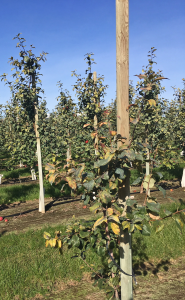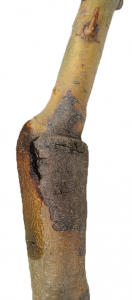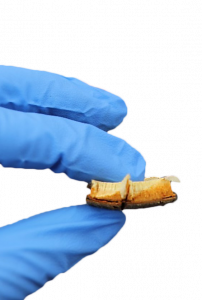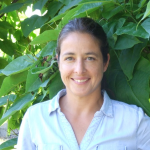Written by Scott J. Harper, WSU Plant Pathology, March 2020.
Apple decline, an emerging problem for apple production in both the U.S. and Canada, is characterized by the rapid dieback of young trees. Many potential causes have been proposed, including genetic incompatibility, winter injury, herbicide damage, and pathogens (bacteria, fungi, and viruses).
During 2018-2019 my lab investigated two aspects of apple decline in Washington state: a) what were the common symptoms of decline, and b) whether viruses could be the cause of the disease. We focused Honeycrisp variants grown on G.935 rootstock, as this was the primary combination where disease was reported.
We found that the visual symptoms of decline, the dieback of shoots, tips and leaves on the upper scion were due to necrosis of the rootstock below the graft union. The necrosis extended into the phloem of the roots, indicating that the dieback of the scion is due to the gradual death of the rootstock. The root systems of diseased trees were also observed to be sparse and weak.
Figure 1 A-C. Symptoms of apple decline.
Next, we compared the presence of nine apple-infecting viral species in symptomatic and asymptomatic plants to determine whether any of these could be the cause. We found that while diseased plants were on average more heavily infected with more viruses than healthy, there was no correlation between the presence of any single viral species, or combination of viruses, and the expression of disease.
Table 1. Frequency table for viruses detected in symptomatic and asymptomatic Honeycrisp cultivars grown on G.935 rootstock.
| Disease | ACLSV | AGCaV | ApMV | ARWaV-1 | ARWaV-2 | ASGV | ASPV | CCGaV | AhVd |
| Symptomatic | 48% | 13% | 54% | 2% | 54% | 62% | 62% | 21% | 38% |
| Asymptomatic | 6% | 0% | 33% | 0% | 6% | 44% | 33% | 22% | 22% |
Finally, we sequenced a subset of disease trees and searched for novel viruses. In total we found 17 putative new viruses; only three are likely to be plant-infecting while the rest are fungi or insect-infecting. However, the new viruses were rare, being found in 1-2 plants each, so are not related to the onset of apple decline.
From this data we concluded that apple-infecting viruses are not the primary cause of decline of Honeycrisp on G.935 rootstock, therefore we conducted a brief examination of other pathogens present. By sequencing we found Fusarium oxysporum, Leptosphairea biglobosa, Leptosphairea macculans, Nectria haematococca, and Rhizoctonia solani, pathogens that are known to cause root rot in other species, though again, this was not consistent. Furthermore, during the 2019 season we observed several trees that showed symptoms of back cracking and necrosis above the graft union. After further study we found that this was likely due to winter injury combined with an opportunistic infection by Valsa ceratospora.
In summary, while many viruses have been identified as being present in symptomatic trees, there is no clear association between virus species and the onset of decline symptoms. This does not exclude a secondary role for viruses in this disease, perhaps weakening the plant for subsequent infection/damage by an unknown agent. However, the data does not support active management of these viruses for the purpose of preventing apple decline, rather management to promote general plant health, and the prevention of the diseases that they do cause.
Contact:
WSU Tree Fruit Extension
email: b.sallato@wsu.edu
phone: 509-786-9205
Treefruit.wsu.edu articles may only be republished with prior author permission © Washington State University. Republished articles with permission must include: “Originally published by Washington State Tree Fruit Extension Fruit Matters at treefruit.wsu.edu” along with author(s) name, and a link to the original article.




